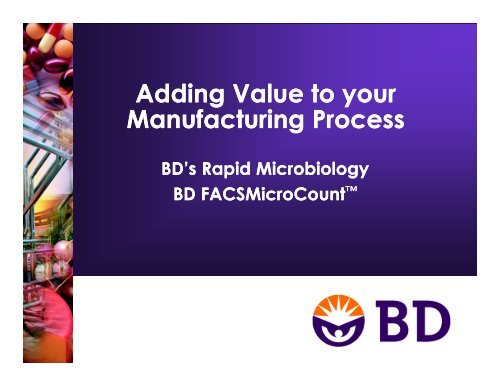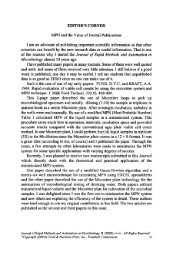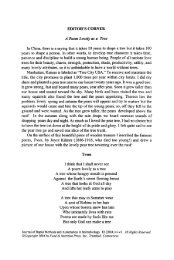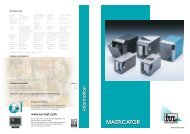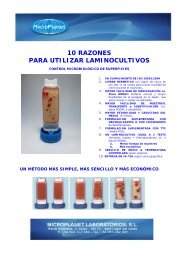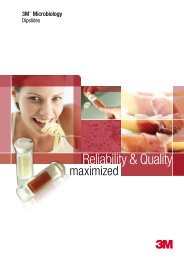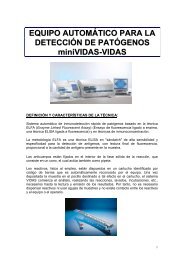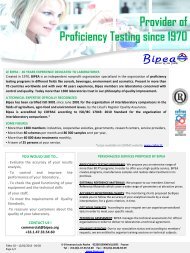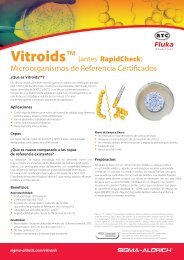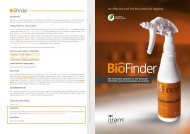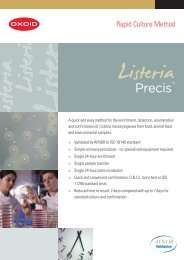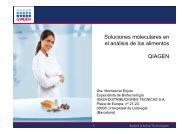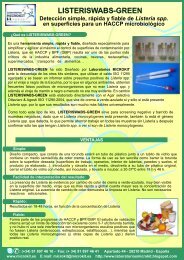Adding value to your manufacturing process
Adding value to your manufacturing process
Adding value to your manufacturing process
Create successful ePaper yourself
Turn your PDF publications into a flip-book with our unique Google optimized e-Paper software.
<strong>Adding</strong> Value <strong>to</strong> <strong>your</strong><br />
Manufacturing Process<br />
BD’s Rapid Microbiology<br />
BD FACSMicroCount BD FACSMicroCount
In Production….<br />
• Contamination detection<br />
• Scaling-up Operations<br />
• Loss of materials, intermediates and<br />
finished products<br />
• production time and profit<br />
• LEAN <strong>manufacturing</strong><br />
• Risk Evaluation<br />
Challenges<br />
For For Management….<br />
Management….<br />
• Overall operation of the plant<br />
• Profitability<br />
• LEAN <strong>manufacturing</strong><br />
• Reduction of overhead cost<br />
At the QA/QC ….<br />
• Labour & Resources<br />
• Time <strong>to</strong> Results<br />
• S<strong>to</strong>rage Requirements –<br />
Fridge/Incuba<strong>to</strong>r Capacity<br />
• Repeatable and Reproducible<br />
results<br />
• Subjectivity<br />
• OOS Management<br />
• Reduction of inven<strong>to</strong>ry/warehouse<br />
• Return Of Investment
Current status RMM<br />
Regula<strong>to</strong>ry guidance documents since 2000<br />
Easier registration <strong>process</strong> of <strong>your</strong> RMM application<br />
> 10 new RMM applications filed in US in 2011<br />
+/- 50 RMM Technologies available on the market:<br />
http://rapidmicromethods.com/files/matrix.html<br />
Everyone is considering/evaluating RMM applications
BD FACSMicroCount BD FACSMicroCount • Unique proven technology counts living cell<br />
• Quantitative direct results in minutes<br />
• Presence/Absence tests in hours<br />
• Direct labelling and detection technology
The BD FACSMicroCount The BD FACSMicroCount Solution<br />
Solution<br />
SAVES TIME with rapid results<br />
SAVES MONEY by minimizing media & product loss<br />
by reducing warehousing costs<br />
by reducing labor costs<br />
IMPROVES through constant moni<strong>to</strong>ring &<br />
PROCESS optimizing
The BD FACSMicroCount The BD FACSMicroCount Solution<br />
Solution<br />
An easy-<strong>to</strong>-use, fully au<strong>to</strong>mated system<br />
Provides rapid, objective results<br />
Replaces time and labor-intensive microbiological methods
The BD FACSMicroCount System<br />
• Versatile system<br />
Quantitative<br />
Qualitative<br />
• Au<strong>to</strong>mated, high throughput analysis with continuous <strong>process</strong>ing capability<br />
• Reagents stable at room temperature for 10 days<br />
• Differentiate microorganism type<br />
Bacteria<br />
Yeast<br />
Mould<br />
• Objective results<br />
Counts/mL<br />
Pass/Fail<br />
• 21 CFR part 11-compliant software
BD FACSMicroCount<br />
Rapid Solution<br />
for Enumeration of Microbes
The Technology<br />
Based on Flow Cy<strong>to</strong>metry<br />
• Cells in a sample are labeled with a fluorescent dye<br />
• Each labeled cell passes through the laser beam emitting<br />
fluorescent and scattered laser light<br />
• The optic and electronic systems capture and record each of the<br />
signals as 1 count<br />
• Provides quantification of microorganisms per volume, yielding<br />
counts/mL results
General Labeling Pro<strong>to</strong>col for<br />
BD FACSMicroCount <br />
BIOMASS Dye<br />
FACSMicroCount<br />
Count / mL<br />
BIOMASS Dye= permeable, labels nucleic acid in and out of the<br />
intact cells<br />
BRAG3= non-permeable, quenches fluorescence out of intact cells
Fluidic System<br />
Sample delivery Sheath delivery<br />
Labeled bacteria<br />
Sheath<br />
flow<br />
Core flow<br />
• Quantitative cell delivery<br />
• Hydrodynamic Focusing<br />
• Single File Passage<br />
through detection region
Fluorescence<br />
Detec<strong>to</strong>r<br />
Scatter<br />
Detec<strong>to</strong>r<br />
Optic System<br />
Scatter<br />
signal<br />
Fluorescence<br />
signal<br />
High performance<br />
optical filters<br />
Fluorescence plus Scatter<br />
= One Count<br />
Labeled<br />
microorganism<br />
Laser Beam –<br />
shaped and focused;<br />
635 nm<br />
laser excitation
Au<strong>to</strong>mated, High-Throughput Analysis<br />
• Qualitative Analysis (Presence/Absence)<br />
20 samples/hour<br />
• Quantitative Analysis (Enumeration)<br />
12-15 samples/hour<br />
• Holds up <strong>to</strong> 42 samples at once<br />
• Au<strong>to</strong>matically<br />
adds reagents<br />
mixes samples<br />
cleaning
Workflow of BD FACSMicroCount<br />
• BD FACS MicroCount
Example of BD FACSMicroCount<br />
INTENSITY PLOT<br />
2D picture of each count detected and recorded in the sample<br />
Each blue dot = 1 count; colors indicate multiple counts at same point<br />
Cell<br />
size<br />
Amount of label
BD FACSMicroCount All Applications<br />
Cosmetics<br />
Vaccines<br />
Water<br />
Surface<br />
Support<br />
General<br />
Product test<br />
Fermentation<br />
Mycoplasma<br />
S<strong>to</strong>ck cultures
Quantitative Analysis<br />
• Detects bioburden in viral vaccine<br />
intermediates (egg-harvest material)<br />
• Microbial Fermentation Moni<strong>to</strong>ring<br />
• Screening Process Water<br />
• Counting QC S<strong>to</strong>ck Cultures<br />
• Detecting Surface Contamination<br />
• Easy-<strong>to</strong>-use<br />
• Rapid screening solution<br />
• Reliable, quantitative results in less than 5<br />
minutes
Micro PRO TM Counts (log10 counts/mL)<br />
Correlation of BD FACSMicroCount<br />
7.0<br />
6.0<br />
5.0<br />
4.0<br />
3.0<br />
2.0<br />
1.0<br />
0.0<br />
vs. Plate Counts<br />
E.coli Ps. aeruginosa S. aureus C. albicans A. niger<br />
R 2 = 0.9917<br />
R 2 = 0.9939<br />
R 2 = 0.9986<br />
R 2 = 0.9916<br />
R 2 = 0.9952<br />
0.0 1.0 2.0 3.0 4.0 5.0 6.0 7.0<br />
Plate Counts (log10 cfu/mL)<br />
E. coli ATCC 25922 (n=48); Ps. aeruginosa ATCC 9027 (n=35);<br />
S. aureus ATCC 6538 (n=30); C. albicans ATCC 10231 (n=15); A. niger ATCC 16404 (n=12)
Microorganisms Enumerated<br />
with BD FACSMicroCountTM Microorganisms Enumerated<br />
with BD FACSMicroCountTM • Aeromonas caviae<br />
• Aeromonas hydrophila<br />
• Aspergillus niger spores<br />
• Bacillus atrophaeus<br />
• Bacillus atrophaeus spores<br />
• Bacillus pumilus<br />
• Bacillus pumilus spores<br />
• Bacillus subtilis<br />
• Bacillus subtilis spores<br />
• Bordetella bronchisceptica<br />
• Brachyspira hyodysenteriae<br />
• Burkholderia cepacia<br />
• Campylobacter jejuni<br />
• Candida albicans<br />
• Candida glabrata<br />
• Citrobacter freundii<br />
• Clostridium perfringens<br />
• Cryp<strong>to</strong>coccus spp.<br />
• Cryp<strong>to</strong>sporidium parvum<br />
oocysts<br />
• Enterobacter aerogenes<br />
• Enterobacter cloacae<br />
• Enterococcus casseliflavus<br />
• Enterococcus durans<br />
• Enterococcus faecium<br />
• Enterococcus faecalis<br />
• Enterococcus gallinarum<br />
• Enterococcus hirae<br />
• Enterococcus mundtii<br />
• Erysipelothrix rhusiopathiae<br />
• Escherichia coli<br />
• Escherichia coli O157:H7<br />
• Escherichia coli O25:HN<br />
• Escherichia coli O15:NM<br />
• Escherichia coli O1:NM<br />
• Escherichia coli O7:NM<br />
• Escherichia coli O78:NM<br />
• Escherichia coli ON:H8<br />
• Escherichia coli ON:NM<br />
• Escherichia coli O8:HN<br />
• Geobacillus<br />
stearothermophilus<br />
• Geobacillus<br />
stearothermophilus spores<br />
• Giardia lamblia cysts<br />
• Haemophilus parasuis<br />
• Haemophilus somnus<br />
• Halobacterium salinarum<br />
• Klebsiella pneumoniae<br />
• Lac<strong>to</strong>bacillus acidophilus<br />
• Lac<strong>to</strong>bacillus casei<br />
• Lac<strong>to</strong>bacillus delbrueckii<br />
• Lac<strong>to</strong>bacillus lindneri<br />
• Lac<strong>to</strong>bacillus plantarum<br />
• Lac<strong>to</strong>coccus lactis<br />
• Lawsonia intracellularis<br />
• Lep<strong>to</strong>spira pomona<br />
• Listeria grayi<br />
• Listeria innocua<br />
• Listeria ivanovii<br />
• Listeria monocy<strong>to</strong>genes<br />
• Listeria seeligeri<br />
• Listeria welshimeri
Microorganisms Enumerated<br />
with BD FACSMicroCount TM<br />
• Micrococcus candicans<br />
• Micrococcus luteus<br />
• Moraxella bovis<br />
• Mycoplasma bovis<br />
• Mycoplasma hyopneumoniae<br />
• Nannocystis exedens<br />
• Oxalobacter formigenes<br />
• Pan<strong>to</strong>ea agglomerans<br />
• Pasteurella mul<strong>to</strong>cida<br />
• Pediococcus acidilactici<br />
• Pediococcus damnosus<br />
• Proteus mirabilis<br />
• Pseudomonas aeruginosa<br />
• Pseudomonas fluorescens<br />
• Pseudomonas putida<br />
• Rals<strong>to</strong>nia pickettii<br />
• Raoutella terrigena<br />
• Saccharomyces cerevisiae<br />
• Salmonella adelaide<br />
• Salmonella anatum<br />
• Salmonella choleraesuis<br />
• Salmonella dublin<br />
• Salmonella enteriditis<br />
• Salmonella hadar<br />
• Salmonella heidelberg<br />
• Salmonella iverness<br />
• Salmonella schalwijk<br />
• Salmonella typhimurium<br />
• Salmonella worthing<strong>to</strong>n<br />
• Serratia marcescens<br />
• Shigella boydii<br />
• Staphylococcus aureus<br />
• Staphylococcus epidermidis<br />
• Staphylococcus saprophyticus<br />
• Stenotrophomonas mal<strong>to</strong>phila<br />
• Strep<strong>to</strong>coccus bovis<br />
• Strep<strong>to</strong>coccus equinus<br />
• Strep<strong>to</strong>coccus pyogenes<br />
• Tsukamurella paurometabola
Qualitative Analysis<br />
Product Screening
Presence/Absence Test<br />
• Screen products for microbial contamination<br />
Raw materials, in-<strong>process</strong> samples, finished products<br />
• Detect bacteria, yeast & mold in 1 test<br />
• Next day results for product release<br />
• Various Matrices:<br />
liquids powders<br />
gels tablets<br />
emulsions natural extracts<br />
ointments<br />
Product Screening<br />
• Complete Kit with media & consumables
BD FACSMicroCountTM BD FACSMicroCount versus Traditional<br />
TM versus Traditional<br />
• No need <strong>to</strong> use different pro<strong>to</strong>col and media <strong>to</strong> culture Bacteria, Yeasts and<br />
Moulds<br />
Growth Enhancement<br />
Media<br />
TSA + SDA<br />
• No need <strong>to</strong> wait additional days until results for Yeasts and Moulds are also<br />
available. Length of incubation is the same for Bacteria, Yeasts and Moulds.<br />
24 Hours of incubation<br />
and 5 min. testing<br />
Up<strong>to</strong> 5-7 Days for final<br />
results incl. Bacteria, Yeasts<br />
and Moulds<br />
• For most of the matrices results are available within 24 hours for Bacteria,<br />
Yeasts and Moulds in a single sample
BD FACSMicroCount TM Pro<strong>to</strong>col<br />
Bacteria, Yeast & Mold<br />
1:10<br />
dilution of<br />
product<br />
30ºC shaking<br />
for 24 hours<br />
1ml in<br />
Tube A<br />
Incubate 24<br />
<strong>to</strong> 48 hours<br />
at 30°C<br />
10 min at<br />
room<br />
temperature<br />
2 mL<br />
0.1 mL<br />
2.9 mL<br />
Transfer substrate<br />
Tube A <strong>to</strong><br />
Tube B; vortex;<br />
0.1mL <strong>to</strong> Tube C<br />
Detection on the<br />
BD FACS<br />
MicroCount<br />
FACSMicroCount
Results<br />
• BD FACSMicroCount output shows many counts within the area<br />
definition (>3x product baseline)<br />
• Fail result indicates that the sample contains microbial contamination<br />
Bacteria
Personal Care Products<br />
Result Summery<br />
Enrichment Time – Positive for Bacteria, Yeast<br />
& Mold<br />
Face scrub 24 hrs<br />
Hair gel 24 hrs<br />
Hand soap, antibacterial 24 hrs<br />
Lotion 24 hrs<br />
Mouthwash 24 hrs<br />
Shampoo 24 hrs<br />
Shave gel 24 hrs<br />
Sunscreen 24 hrs<br />
Toothpaste 30 hrs<br />
Others<br />
Enrichment Time – Positive for Bacteria,<br />
Yeast & Mold<br />
Excipients 24 hrs<br />
Household cleaner 24 hrs<br />
Industrial Emulsions 24 hrs<br />
Antioxidant water 24 hrs<br />
Cranberry juice 24 hrs<br />
Lemonade 24 hrs<br />
Vegetable juice 48 hrs
Cosmetics Screening<br />
Using the BD FACSMicroCount TM
Objetive<br />
• Demonstrate the capability of MicroCount Product Screening<br />
procedure <strong>to</strong> detect low-levels of microorganisms in various products<br />
commonly used (shampoo, brown tinted make up and facial cream)<br />
within 24 – 48 hours.<br />
• To detect at least 20 cfu of Escherichia coli, ATCC 25922 and Candida<br />
albicans, ATCC 60193 in 1 gram of the original product<br />
• To perform and demonstrate that the EUGON broth as enrichment<br />
medium can be used in combination with the BD FACS MicroCount<br />
platform, providing a pass/ fail (presence/ absence) result.
1 gr of the original<br />
sample<br />
+ 100 ml Eugon<br />
LT100<br />
A<br />
B<br />
Experimental procedure<br />
Wait 30<br />
min<br />
Take 100µL in 2.9 ml<br />
of PB with filter cap<br />
(tube C)<br />
Perform 1:10 or<br />
1:30 dilution in<br />
saline solution<br />
Spike the sample with<br />
20 cfu of bacterium<br />
Take 100µL<br />
in 2.9 mL<br />
with filter<br />
cap<br />
Incubate<br />
24 hours<br />
30ºC
Sham poo undiluted<br />
Results on Shampoo<br />
Yeast<br />
Bacteria<br />
The growth of E.coli is clearly visible after 24hr of<br />
incubation.<br />
C. albicans was visible after 48 hours.
Results make-up and facial cream<br />
Make up<br />
Facial cream 1/10 diluted<br />
E.coli C. albicans (48 hours)<br />
The growth of E.coli<br />
is clearly visible after<br />
24hr of incubation.<br />
C. albicans was<br />
visible after 48 hours.
Conclusion<br />
This feasibility study shows that BD FACS MicroCount Product<br />
Screening method can be used <strong>to</strong> detect yeast and bacteria in a<br />
variety of personal care and cosmetic products.<br />
This broth shows <strong>to</strong> be an acceptable growth enhancement medium <strong>to</strong><br />
be used. It was shown that we can meet the requirement of detect<br />
presence/ absence in 1 gram of product within 24-48 hours after growth<br />
enhancement in Eugon medium.<br />
Early time <strong>to</strong> result (≤48 hours) using the BD FACS MicroCount for<br />
microbiology samples translates directly <strong>to</strong> savings from reduced<br />
<strong>manufacturing</strong> cycle times and inven<strong>to</strong>ry levels, improved warehouse<br />
utilization and reduction in labor and waste costs. Additional water and<br />
environmental testing using the BD FACS MicroCount may prevent<br />
<strong>manufacturing</strong> at risk and exposing product <strong>to</strong> potential microbial<br />
contamination.
Cus<strong>to</strong>mer Cases<br />
• Direct Enumeration<br />
• Medimmune Egg-based vaccine production; Allan<strong>to</strong>ic fluid.<br />
• In-<strong>process</strong> control <strong>to</strong> avoid loss of batches<br />
• Bacardi Control of filtered water<br />
• Ongoing Control <strong>to</strong> determine the replacement time of filter<br />
cartridges<br />
• Product Screening<br />
• Baby Wipes Detection of bioburden in finished product<br />
• Tablets & capsules Detection of bioburden in finished<br />
products<br />
• BTG Detection of contamination in FSH and Hyaluronic Acid<br />
• Cosmetics Product Screening
BD FACSMicroCount
Nuevas soluciones para el análisis rápido y au<strong>to</strong>matizado en<br />
microbiología industrial<br />
BD Diagnostics – Diagnostic Systems<br />
X workshop sobre Mé<strong>to</strong>dos Rápidos y Au<strong>to</strong>matización en Microbiología Alimentaria<br />
(MRAMA)
BD Diagnostics – Diagnostics Systems<br />
Líneas de produc<strong>to</strong> en microbiología industrial<br />
• Control de ambiente y pruebas de esterilidad.<br />
• Control de calidad.<br />
X workshop sobre Mé<strong>to</strong>dos Rápidos y Au<strong>to</strong>matización en Microbiología Alimentaria (MRAMA)
Control de ambiente y pruebas de esterilidad<br />
Placas estériles<br />
• Isola<strong>to</strong>r pack – Isola<strong>to</strong>r pack XT (SAL 10 -5 ).<br />
• TSA, RODAC<br />
• Sterile pack (SAL 10 -5 ).<br />
• TSA con lecitina y polisorba<strong>to</strong> 80<br />
• Irradiadas (SAL 10 -3 ).<br />
Botellas estériles<br />
Torundas<br />
• Sterile pack.<br />
• Sterile pack.<br />
X workshop sobre Mé<strong>to</strong>dos Rápidos y Au<strong>to</strong>matización en Microbiología Alimentaria (MRAMA)
Control de ambiente y pruebas de esterilidad<br />
Características BD BBL Isola<strong>to</strong>r Pack XT<br />
• Triple envol<strong>to</strong>rio impermeable, cierre hermético y<br />
transparente.<br />
• Uso en salas limpias y aisladores.<br />
• Protección frente a VHP.<br />
• Temperatura de almacenaje 5-25 ºC.<br />
• Vida útil: 24 semanas.<br />
• SAL 10 -5<br />
X workshop sobre Mé<strong>to</strong>dos Rápidos y Au<strong>to</strong>matización en Microbiología Alimentaria (MRAMA)
Control de ambiente y pruebas de esterilidad<br />
Placas de contac<strong>to</strong> BD RODAC<br />
• Base ancha fácil de agarrar y de aplicar a superficies.<br />
• Patrón de cuadrícula interno que no interfiere con los marcadores<br />
• La base convexa de la placa ofrece un mejor contac<strong>to</strong> entre el agar y la<br />
superficie a evaluar.<br />
X workshop sobre Mé<strong>to</strong>dos Rápidos y Au<strong>to</strong>matización en Microbiología Alimentaria (MRAMA)<br />
Patrón de cuadrícula interno<br />
Amplios bordes de fácil manejo Base convexa
Control de ambiente y pruebas de esterilidad<br />
BD RODAC<br />
• Proporciona un ajuste suel<strong>to</strong> entre tapa y base.<br />
• Su diseño facilita la manipulación con una sola<br />
mano.<br />
• Permite una <strong>to</strong>ma rápida de muestras.<br />
BD RODAC SL<br />
• Proporciona una conexión fija entre la base y la<br />
tapa.<br />
• Reduce la contaminación accidental.<br />
• Mejora la seguridad de la muestra<br />
X workshop sobre Mé<strong>to</strong>dos Rápidos y Au<strong>to</strong>matización en Microbiología Alimentaria (MRAMA)
Control de calidad<br />
Medios de cultivo generales, selectivos y diferenciales.<br />
• Medios deshidratados.<br />
• Medios preparados en botellas – placa – tubo<br />
Medios específicos para cultivo e identificación:<br />
• Medios cromogénicos: BD BBL CHROMagar<br />
• BD HyCheck <br />
Sistemas miniaturizados de identificación:<br />
• BD Enterotube II – BD Oxi/Ferm II<br />
• BD BBL Crystal <br />
Sistemas au<strong>to</strong>máticos de identificación:<br />
• BD Phoenix 100<br />
X workshop sobre Mé<strong>to</strong>dos Rápidos y Au<strong>to</strong>matización en Microbiología Alimentaria (MRAMA)
Control de calidad<br />
Medios de cultivo generales, selectivos y diferenciales.<br />
• Medios deshidratados.<br />
• Medios preparados en botellas – placa – tubo<br />
Medios específicos para cultivo e identificación:<br />
• Medios cromogénicos: BD BBL CHROMagar<br />
• BD HyCheck <br />
Sistemas miniaturizados de identificación:<br />
• BD Enterotube II – BD Oxi/Ferm II<br />
• BD BBL Crystal <br />
Sistemas au<strong>to</strong>máticos de identificación:<br />
• BD Phoenix 100<br />
X workshop sobre Mé<strong>to</strong>dos Rápidos y Au<strong>to</strong>matización en Microbiología Alimentaria (MRAMA)
Control de calidad<br />
Medios específicos para cultivo e identificación<br />
BD BBL CHROMagar<br />
Medios preparados en placa que permiten un rápido aislamien<strong>to</strong> e identificación de<br />
diferentes grupos microbianos.<br />
• BD BBL CHROMagar Staphylococcus aureus.<br />
• BD BBL CHROMagar Salmonella.<br />
• BD BBL CHROMagar O157.<br />
• BD BBL CHROMagar Listeria.<br />
X workshop sobre Mé<strong>to</strong>dos Rápidos y Au<strong>to</strong>matización en Microbiología Alimentaria (MRAMA)
Control de calidad<br />
Medios específicos para cultivo e identificación<br />
BD BBL CHROMagar Staph aureus<br />
X workshop sobre Mé<strong>to</strong>dos Rápidos y Au<strong>to</strong>matización en Microbiología Alimentaria (MRAMA)<br />
BBL CHROMagar Staph aureus (prepared<br />
plated medium) has been validated by the<br />
AOAC Research Institute under the<br />
Performance Tested Methods Program for the<br />
analysis of shell eggs, smoked salmon and<br />
cooked roast beef when using AOAC and<br />
ISO methods.<br />
An advantage BBL CHROMagar Staph aureus<br />
has over some traditional media, such as Baird-<br />
Parker Agar, is the ability <strong>to</strong> identify S.<br />
aureus in 24 h as opposed <strong>to</strong> 48 h.
Control de calidad<br />
Medios específicos para cultivo e identificación<br />
BD BBL CHROMagar Salmonella<br />
X workshop sobre Mé<strong>to</strong>dos Rápidos y Au<strong>to</strong>matización en Microbiología Alimentaria (MRAMA)<br />
BBL CHROMagar Salmonella has been<br />
validated by the AOAC Research Institute<br />
under the Performance Tested Methods<br />
program only for the analysis of raw ground<br />
beef, raw chicken, raw fish, lettuce and shell<br />
eggs. ISO, USDA, FSIS, and FDA, BAM<br />
methods were used for method comparison<br />
testing. BBL CHROMagar Salmonella was<br />
found <strong>to</strong> be equivalent <strong>to</strong> the plated media<br />
recommended in the ISO, FDA and USDA<br />
methods.
Control de calidad<br />
Medios específicos para cultivo e identificación<br />
BD BBL CHROMagar O157<br />
X workshop sobre Mé<strong>to</strong>dos Rápidos y Au<strong>to</strong>matización en Microbiología Alimentaria (MRAMA)<br />
BBL CHROMagar O157 has been validated by<br />
the AOAC-Research Institute under<br />
the Performance Tested Methods Program for<br />
the analysis of raw ground beef and<br />
unpasteurized apple cider
Control de calidad<br />
Medios específicos para cultivo e identificación<br />
BD BBL CHROMagar Listeria<br />
X workshop sobre Mé<strong>to</strong>dos Rápidos y Au<strong>to</strong>matización en Microbiología Alimentaria (MRAMA)
Control de calidad<br />
Medios específicos para cultivo e identificación<br />
BD HyCheck<br />
Tarjetas de contac<strong>to</strong> diseñadas para control de higiene<br />
ambiental de superficies y líquidos.<br />
• Las láminas están impregnadas por ambas caras con un<br />
medio de cultivo (idéntico o diferente) y ensambladas<br />
sobre un eje flexible, que facilita el muestreo.<br />
• Dependiendo del tipo de medio, permiten la selección<br />
de un determinado grupo de microorganismos.<br />
• Fácil de transportar en un tubo con cierre a rosca.<br />
X workshop sobre Mé<strong>to</strong>dos Rápidos y Au<strong>to</strong>matización en Microbiología Alimentaria (MRAMA)
Control de calidad<br />
Medios específicos para cultivo e identificación<br />
BD Hycheck - tipo de medios de cultivo<br />
• BD Hycheck para la detección de Enterobacteriaceae,<br />
con agar pep<strong>to</strong>na de soja y de caseína por una cara y agar<br />
glucosa-bilis-rojo neutro y cristal violeta.<br />
• BD Hycheck para el control de desinfección,<br />
• Agar D/E Neutralizing en ambas caras<br />
• Agar D/E Neutralizing y agar pep<strong>to</strong>na de soja y caseína<br />
• BD Hycheck para hongos y levaduras, con TSA y rosa de<br />
bengala con cloranfenicol.<br />
• BD Hycheck para hongos y levaduras, con TSA + 0,01 %<br />
TTC y agar rosa de bengala con cloranfenicol.<br />
• BD Hycheck Plate Count Agar más TTC.<br />
• BD Hycheck Total Count, con PCA y PCA + TTC.<br />
X workshop sobre Mé<strong>to</strong>dos Rápidos y Au<strong>to</strong>matización en Microbiología Alimentaria (MRAMA)
Control de calidad<br />
Medios de cultivo generales, selectivos y diferenciales.<br />
• Medios deshidratados.<br />
• Medios preparados en botellas – placa – tubo<br />
Medios específicos para cultivo e identificación:<br />
• Medios cromogénicos: BD BBL CHROMagar<br />
• BD HyCheck <br />
Sistemas miniaturizados de identificación:<br />
• BD Enterotube II – BD Oxi/Ferm II<br />
• BD BBL Crystal <br />
Sistemas au<strong>to</strong>máticos de identificación:<br />
• BD Phoenix 100<br />
X workshop sobre Mé<strong>to</strong>dos Rápidos y Au<strong>to</strong>matización en Microbiología Alimentaria (MRAMA)
Control de calidad<br />
Sistemas miniaturizados de identificación<br />
• Sistemas rápidos (4-48 horas), seguros y con resultados<br />
fiables.<br />
• Sistemas herméticos de fácil manipulación, < 1 minu<strong>to</strong> por<br />
test.<br />
• Gran número de sustra<strong>to</strong>s bioquímicos (15-30) para realizar<br />
una identificación más precisa.<br />
• Pocas pruebas previas – sin revelado de resultados<br />
• Gran base de da<strong>to</strong>s de identificación de microorganismos,<br />
incluyendo gran cantidad de bacterias ambientales.<br />
• Más de 80 especies con BD BBL Enterotube II – BD<br />
BBL Oxi/Ferm II.<br />
• 370 especies con BD BBL Crystal (paneles para GP,<br />
EN/F, ANR y N/H).<br />
X workshop sobre Mé<strong>to</strong>dos Rápidos y Au<strong>to</strong>matización en Microbiología Alimentaria (MRAMA)
Control de calidad<br />
Sistemas miniaturizados de identificación<br />
BD BBL Enterotube II – BD BBL Oxi/Ferm II<br />
BBL Enterotube II es un sistema de identificación lis<strong>to</strong> para usar<br />
que se emplea en la identificación de Enterobacteriaceae y otros<br />
bacilos gram negativos con resultado negativo a la oxidasa.<br />
BBL Oxi/Ferm Tube II es un sistema de identificación lis<strong>to</strong> para<br />
usar en bacterias gram negativas fermentadoras positivas a la<br />
oxidasa y no fermentadoras gram negativas, aisladas a partir de<br />
muestras clínicas.<br />
X workshop sobre Mé<strong>to</strong>dos Rápidos y Au<strong>to</strong>matización en Microbiología Alimentaria (MRAMA)
Control de calidad<br />
Sistemas miniaturizados de identificación<br />
BD BBL Enterotube II<br />
Lectura de la prueba<br />
Sin Voges-Proskauer<br />
Con Voges- Proskauer<br />
X workshop sobre Mé<strong>to</strong>dos Rápidos y Au<strong>to</strong>matización en Microbiología Alimentaria (MRAMA)
Control de calidad<br />
Sistemas miniaturizados de identificación<br />
BD BBL Oxi/Ferm II<br />
Lectura de la prueba<br />
X workshop sobre Mé<strong>to</strong>dos Rápidos y Au<strong>to</strong>matización en Microbiología Alimentaria (MRAMA)
Control de calidad<br />
Sistemas miniaturizados de identificación<br />
BD BBL Enterotube II – BD BBL Oxi/Ferm II<br />
Bases de da<strong>to</strong>s:<br />
BD BBL Enterotube II Biocode manual (con o sin VP)<br />
• Bacterias Gram negativas, oxidasa negativas y fermentadoras.<br />
• Bacterias Gram negativas, oxidasa negativas y no fermentadoras: Acine<strong>to</strong>bacter,<br />
Stenotrophomonas, Burkholderia, …<br />
BD BBL Oxi/Ferm II Biocode manual<br />
• Bacterias Gram negativas, oxidasa positivas<br />
X workshop sobre Mé<strong>to</strong>dos Rápidos y Au<strong>to</strong>matización en Microbiología Alimentaria (MRAMA)
Control de calidad<br />
Sistemas miniaturizados de identificación<br />
BD BBLCrystal<br />
• Sistema de identificación manual o semiau<strong>to</strong>mático (BD<br />
BBL Crystal Au<strong>to</strong>reader).<br />
• 29 ó 30 sustra<strong>to</strong>s bioquímicos: fluorogénicos, cromogénicos<br />
y azúcares).<br />
• Paneles especificos para determinados grupos de bacterias:<br />
• Entéricos/No Fermentadores (E/NF)<br />
• Gram Positivos (GP)<br />
• Microorganismos exigentes: Neisseria/Haemophilus<br />
(N/H)<br />
• Microorganismos anaerobios (ANR).<br />
• Base de da<strong>to</strong>s BD BBL Crystal MIND<br />
X workshop sobre Mé<strong>to</strong>dos Rápidos y Au<strong>to</strong>matización en Microbiología Alimentaria (MRAMA)
Control de calidad<br />
Sistemas miniaturizados de identificación<br />
BD BBLCrystal<br />
Calculo del perfil bioquímico<br />
• Manual, utilizando BD BBL Crystal Panel Viewer<br />
X workshop sobre Mé<strong>to</strong>dos Rápidos y Au<strong>to</strong>matización en Microbiología Alimentaria (MRAMA)<br />
4<br />
A B C D E F G H I J<br />
CTRL<br />
+ + - - - - + - -<br />
2 + - - - + - - + + +<br />
1 - + - - + + + - - +<br />
P 2 5 4 0 3 1 1 6 2 3<br />
• Au<strong>to</strong>mático, utilizando BD BBL Crystal Au<strong>to</strong>reader.
Control de calidad<br />
Sistemas miniaturizados de identificación<br />
BD BBLCrystal<br />
Interpretación del perfil bioquímico<br />
• BD BBL Crystal MIND<br />
X workshop sobre Mé<strong>to</strong>dos Rápidos y Au<strong>to</strong>matización en Microbiología Alimentaria (MRAMA)
Control de calidad<br />
Sistemas miniaturizados de identificación<br />
BD BBLCrystal<br />
Base de da<strong>to</strong>s<br />
• Gram positivos (165): Micrococcus, Staphylococcus, S<strong>to</strong>ma<strong>to</strong>coccus,<br />
Strep<strong>to</strong>coccus (S. pneumoniae, beta-hemolíticos, otros), Alloiococcus,<br />
Lac<strong>to</strong>coccus, Globicatella, Gemella, Helcococcus, Enterococcus, Pediococcus,<br />
Leuconos<strong>to</strong>c, Erysipelothrix, Listeria, Corynebacterium, Bacillus, Gardnerella.<br />
• Gram negativos (140): Acine<strong>to</strong>bacter, Achromobacter, Actinobacillus,<br />
Aeromonas, Agrobacterium, Alcaligenes, Brevundimonas, Burkholderia,<br />
Cardiobacterium, grupos CDC, Edwarsiella, Eikenella, Enterobacter,<br />
Escherichia, Klebsiella, Moraxella, Pasteurella, Proteus, Providencia,<br />
Pseudomonas, Salmonella, Serratia, Shigella, Stenotrophomonas, Vibrio,<br />
Yersinia.<br />
X workshop sobre Mé<strong>to</strong>dos Rápidos y Au<strong>to</strong>matización en Microbiología Alimentaria (MRAMA)
Control de calidad<br />
Medios de cultivo generales, selectivos y diferenciales.<br />
• Medios deshidratados.<br />
• Medios preparados en botellas – placa – tubo<br />
Medios específicos para cultivo e identificación:<br />
• Medios cromogénicos: BD BBL CHROMagar<br />
• BD HyCheck <br />
Sistemas miniaturizados de identificación:<br />
• BD Enterotube II – BD Oxi/Ferm II<br />
• BD BBL Crystal <br />
Sistemas au<strong>to</strong>máticos de identificación:<br />
• BD Phoenix 100<br />
X workshop sobre Mé<strong>to</strong>dos Rápidos y Au<strong>to</strong>matización en Microbiología Alimentaria (MRAMA)
Control de calidad<br />
Sistemas au<strong>to</strong>máticos de identificación<br />
BD Phoenix 100<br />
Sistema au<strong>to</strong>mático para realizar pruebas de identificación de microorganismos<br />
(bacterias Gram positivas, Gram negativas y levaduras) y pruebas de sensibilidad a<br />
antimicrobianos (bacterias Gram positivas y Gram negativas)<br />
X workshop sobre Mé<strong>to</strong>dos Rápidos y Au<strong>to</strong>matización en Microbiología Alimentaria (MRAMA)<br />
Gran capacidad<br />
• 100 paneles – 200 pruebas<br />
Acceso alea<strong>to</strong>rio<br />
• Ahorro de tiempo<br />
• Flexibilidad
Control de calidad<br />
Sistemas au<strong>to</strong>máticos de identificación<br />
BD Phoenix 100<br />
Consumibles<br />
Diseño<br />
• 51 pocillos de ID (45 substra<strong>to</strong>s)<br />
• 85 pocillos de AST ( CMI real)<br />
Forma<strong>to</strong><br />
• Solo Identificación – solo sensibilidad<br />
• Combo: identificación y sensibilidad<br />
Tipos<br />
• Gram negativos (ID, AST, Combo)<br />
• Gram positivos (ID, AST, Combo)<br />
• Estrep<strong>to</strong>cocos (AST, Combo)<br />
• Levaduras (ID)<br />
Almacenamien<strong>to</strong> a temperatura ambiente<br />
X workshop sobre Mé<strong>to</strong>dos Rápidos y Au<strong>to</strong>matización en Microbiología Alimentaria (MRAMA)
Control de calidad<br />
Sistemas au<strong>to</strong>máticos de identificación<br />
BD Phoenix 100<br />
Características<br />
Flexibilidad de inóculo:<br />
• 0,5 McFarland o 0,25 McFarland<br />
Doble tecnología de detección para una identificación más precisa<br />
• 46 sustra<strong>to</strong>s cromogénicos y fluorogénicos.<br />
Identificación rápida:<br />
Gram negativos<br />
• Enterobacterias: 5,1 h<br />
• No fermentadores: 6,0 h<br />
Gram positivos<br />
• Estrep<strong>to</strong>cocos: 5,8 h<br />
• No estrep<strong>to</strong>cocos: 7,3 h<br />
Levaduras: más del 80 % en menos de 8 h.<br />
Base de da<strong>to</strong>s con más de 300 microorganismos<br />
• Gram negativos – 161<br />
• Gram positivos – 145<br />
• Estrep<strong>to</strong>cocos – 62<br />
• Levaduras - 64<br />
X workshop sobre Mé<strong>to</strong>dos Rápidos y Au<strong>to</strong>matización en Microbiología Alimentaria (MRAMA)
BD Diagnostics – Diagnostics Systems<br />
Certificados y regulación<br />
http://www.bd.com/europe/regula<strong>to</strong>ry/documents.asp<br />
X workshop sobre Mé<strong>to</strong>dos Rápidos y Au<strong>to</strong>matización en Microbiología Alimentaria (MRAMA)
BD Diagnostics – Diagnostics Systems<br />
Página web Industria<br />
http://www.bd.com/es/ds/industry/<br />
X workshop sobre Mé<strong>to</strong>dos Rápidos y Au<strong>to</strong>matización en Microbiología Alimentaria (MRAMA)


